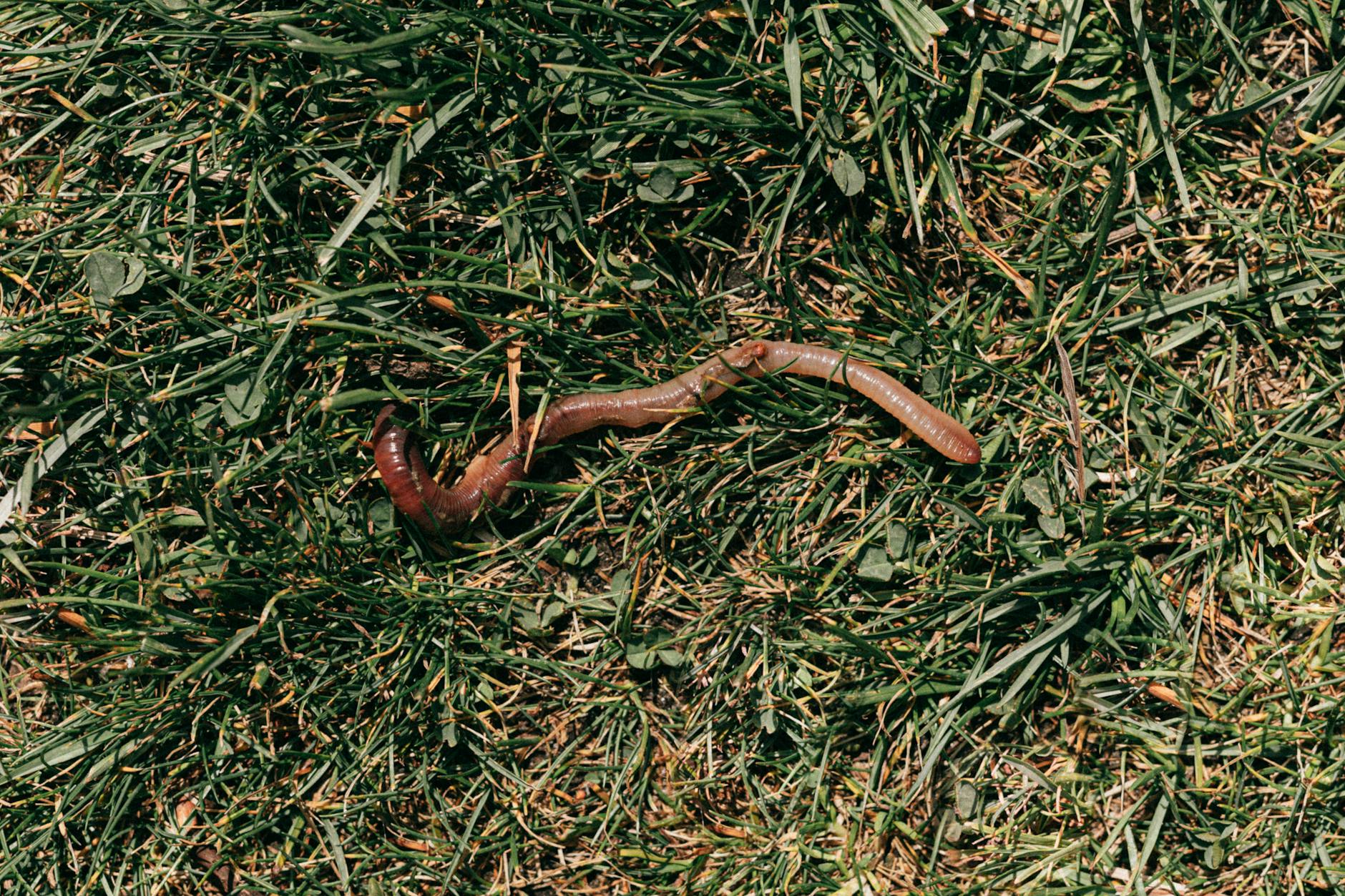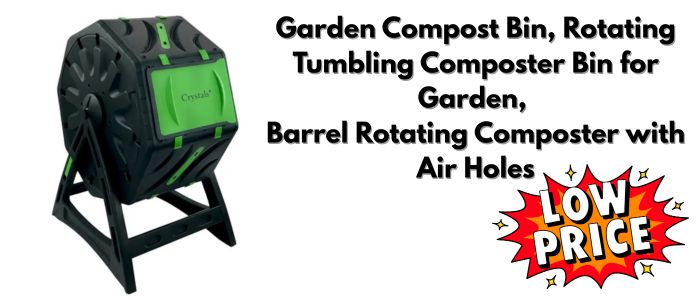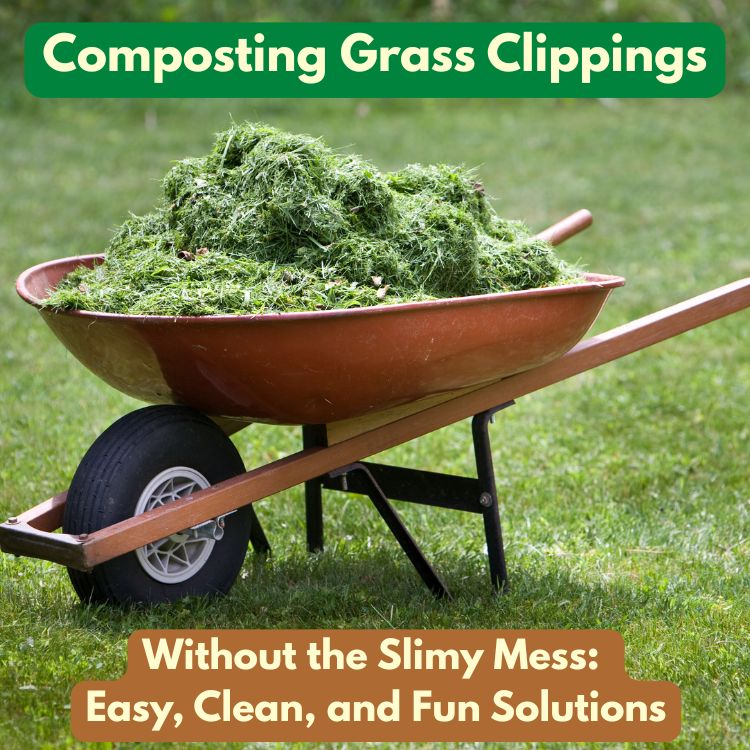Without the Slimy Mess: Easy, Clean, and Fun Solutions
Ever noticed your grass clippings turning into a slimy, sticky mess instead of crumbly, rich compost?
You’re not alone. Composting grass clippings without the slimy mess is possible—and it can be quick, clean, and even fun.
Composting means recycling your yard and kitchen scraps into dark, sweet-smelling compost that nourishes your plants.
It’s an easy way to cut down on waste and make your garden healthier.
But grass clippings are tricky because they pack tightly and hold too much water, leading to that dreaded goo.
This friendly guide shows you how to turn grass clippings into great compost using a compost bin, compost tumbler, or even with worm power—what’s called vermicomposting.
You’ll find answers, see methods that work for busy families, and learn simple tips to avoid problems right from the start.
For deeper guidance on balancing your heap, check out our step-by-step Compost Layering Technique to keep things fresh and mess-free.
What Causes Slimy Grass Clippings in Compost?
Grass clippings are green, juicy, and packed with nitrogen—perfect for boosting your compost pile’s power.
But, like soggy crisps left out overnight, they can quickly turn into a smelly, sticky mess if conditions aren’t just right.
Here’s why that happens, and how to sidestep the goo for easy, crumbly composting grass clippings without the slimy mess.
The Role of Moisture and Air
Too much water and not enough air turn grass clippings into a thick, slimy layer faster than you’d believe.
Imagine stuffing a wet towel at the bottom of your laundry basket for a week—that same trapped moisture breeds bad smells and yucky sludge.
When grass clippings get packed tightly, air can’t circulate through the pile. Oxygen is essential, since friendly composting microbes need it to work their magic.
Without air, the pile turns anaerobic—meaning the microbes that thrive there aren’t the ones we want.
Instead, they make sulfur and ammonia compounds that smell dreadful and break down material very slowly.
Here’s how this happens in simple terms:
- Rain or overwatering: Extra water fills all the spaces, pushing air out.
- Dense packing: Fresh clippings mat together, squashing any air pockets.
- Closed bins or tumblers: Without regular turning or mixing, airflow drops, creating the perfect storm for slime.
Signs you’re headed for a slimy disaster include:
- Clippings turning dark, wet, and sticky
- Strong “rotton egg” or ammonia smells
- Slow or stalled composting
A compost tumbler or a bin with good ventilation helps prevent this. Turning the pile often and adding in chunky materials can make a world of difference.
For helpful tips on tumblers and managing airflow, visit our easy guide on how to use a compost tumbler.
If you want to hear from real gardeners tackling the same problems, this Reddit composting discussion about overly slimy grass piles offers practical advice and shared experiences.
 Photo by Alfo Medeiros
Photo by Alfo Medeiros
The Importance of Carbon-Rich Browns
Here’s where the fun comes in—think of your compost pile like a cake recipe: if you only add wet ingredients, you get batter, not cake.
Grass clippings are packed with “greens” (high in nitrogen and moisture).
To get that sweet, earthy compost, you need to balance the “greens” with “browns”—carbon-rich, dry materials that absorb moisture and let in air.
The best “browns” for grass-heavy compost piles include:
- Shredded fall leaves (nature’s confetti)
- Torn cardboard or paper (nothing glossy)
- Straw or small twigs
How much browns do you need?
A quick rule: aim for at least twice as much brown material as fresh clippings, by volume.
If the pile smells funky or looks soggy, toss in more browns and give it a mix.
Light-hearted tip: If your compost pile gurgles when you poke it, you’re overdue for a cup of “browns” tea!
Too many greens (grass) means slime and smells. Too many browns, and the pile may stall out and take forever to break down.
The right mix keeps everything humming, whether you’re using a compost tumbler, vermicomposting, or piling it up in a heap.
Dry materials do double duty—they keep the pile fluffy for airflow and give bacteria the energy to do their job.
Many home gardeners share that adding browns is their #1 trick to keep things clean and quick, as echoed in tips from Compost Awareness Week’s guide to taming slimy compost.
For a science peek, check out Cornell’s compost chemistry breakdown if you’re curious about the carbon-to-nitrogen ratio in action.
Or, if you need help figuring out the right mix for home compost ratios, this practical guide on home compost ratios for nitrogen and carbon distills it simply.
If you’re just starting and want to explore the many methods for composting, check out our roundup of 6 effective composting methods for a system that fits your space and routine.
Small changes—like a handful of browns for every load of clippings—turn a messy chore into a quick, odor-free win.
Composting grass clippings without the slimy mess is about balance, air, and some creative browns—think of yourself as the DJ mixing the perfect track, only you get garden gold instead of a top 10 hit.
Simple Steps for Composting Grass Clippings Without the Mess
Composting grass clippings without the slimy mess is easier than you might think.
The right habits during mowing, mixing in the perfect “browns,” picking the method that fits your backyard, and paying attention to the pile as it breaks down—all these steps help keep compost neat and odor-free.
Let’s break it down so you can enjoy rich, crumbly compost every time.
Mow Smart and Collect Grass Properly
Careful mowing is the starting point. If you wait too long and let the grass get tall, those clippings become thick and wet, making them prone to turning into a soggy mess in your compost heap.
Keep these tips in mind:
- Cut only a third of the grass height. This keeps clippings short and quick to compost.
- Mow when grass is dry. Wet clippings clump together and encourage slime.
- Use a grass box or mulching mower. A mower with a catcher keeps clippings tidy, while a mulching mower finely chops grass so it breaks down even faster.
Collected clippings should be spread thinly to avoid matting. Let them dry in the sun for a day before you add them to the pile.
This step alone makes a world of difference in keeping the compost heap from turning into a swampy mess.

Photo by hans middendorp
Layer Greens and Browns the Easy Way
For composting grass clippings without the slimy mess, you need the right mix of “greens” (like grass) and “browns” (dry stuff).
Think of layering your compost like making a lasagna—the best flavor comes from getting each layer just right.
- Start with a layer of browns like dry leaves, shredded newspaper, or cardboard. This soaks up extra moisture.
- Add a thin layer of grass clippings. Don’t dump in a giant pile; a little goes a long way.
- Top with another layer of browns. Sandwiching grass keeps airflow moving and stops slimy buildup.
A quick and effective ratio to remember: For every bucket of fresh grass, use at least two buckets of brown, dry material.
If you run short on browns, gather more leaves or hold onto some mail (just skip the glossy stuff!).
The magic here is balancing wet and dry—slimy heaps happen when things are out of sync.
If you want a simple, seasonal plan to keep things tidy, the Composting Calendar Tips guide is full of tricks for year-round composting.
Choosing the Right Composting Method: Bin, Tumbler, or Worms
How you compost can make things even easier—or tougher—when managing grass clippings. Each method has its own perks.
- Compost Bin: Traditional bins are easy to set up and can hold a large pile, but you’ll need to make sure you turn the pile often to keep air flowing.
- Compost Tumbler: Tumblers are perfect for families or anyone wanting less mess. They keep pests out, speed things up, and mixing is as easy as rolling the drum. Tumblers help control moisture—great for slimy grass!
- Vermicomposting: Let worms do the heavy lifting! Vermicomposting uses red wigglers to break down kitchen scraps and small amounts of grass. If your climate or garden is small, this is a tidy, odor-free way to compost.
Learn expert tips for tumblers in the How to use a compost tumbler guide—it covers setup and troubleshooting so you breeze past the toughest problems.
Curious about composting with worms? See the step-by-step How to Start Vermicomposting at Home for everything you need to know, from tiny bins to happy, wriggly worms transforming clippings into garden gold.
Turning, Mixing, and Monitoring
The secret to crumbly, not slimy, compost is movement. Turning or mixing the pile means grass clippings get blended with browns.
It’s like tossing a giant salad for the microbes!
- Turn or tumble your pile once a week, especially after adding fresh clippings.
- Look for steam in the middle—this shows your pile is heating up and breaking down quickly.
- Check for smells. A healthy compost heap has an earthy scent. If you notice ammonia or “rotten egg” odors, add more browns and fluff up the pile.
- Add water only if dry. The pile should feel damp, like a wrung-out sponge—not wet or soggy.
Small, regular check-ins keep slime at bay and let you spot problems early.
If you want an easy starter guide for first-time composters, the Starting Composting at Home article walks through basics and helps avoid beginner mistakes.
Composting grass clippings without the slimy mess is about smart habits and a bit of regular attention.
By mowing well, layering wisely, choosing the right composting method, and giving the pile an occasional mix, you’re on the path to rich, healthy compost that’s ready for your garden—no sludge in sight.
Extra Tips and Common Mistakes to Avoid
No matter how careful you are, composting grass clippings without the slimy mess can sometimes be trickier than expected.
A few smart tweaks and family-friendly ideas can keep composting fun, while sidestepping gooey pitfalls.
Here are some quick fixes, seasonal reminders, and creative ways to get everyone involved.
Troubleshooting: If Your Compost Still Gets Slimy
Even seasoned composters run into goo now and then. If your compost bin or compost tumbler smells sour or looks soggy, don’t worry—there’s always a fix.
- Check the balance: Add twice as much brown, dry material (like leaves or shredded cardboard) to each batch of grass clippings.
- Fluff it up: Mix and turn your pile, or spin your tumbler at least once a week. This helps get oxygen in and moisture out.
- Let clippings dry: If you collect a big pile of grass, spread it out for a day before adding it to compost. This cuts down extra water.
When troubleshooting gets tough, the easiest fixes are sometimes the best. See tips for adjusting your brown materials and learn how paper and cardboard can help in the Composting cardboard and paper guide.
If you’re just starting, common mistakes (like too much green or forgetting to turn the pile) are covered in detail in the Starting composting at home guide, so you won’t be alone if things go sideways.
Seasonal Advice for Year-Round Success
Composting isn’t “set it and forget it”—especially when grass clippings come into play. Your pile will act differently in spring, summer, autumn, and winter.
- Spring and summer: The compost heats up fast. Grass grows quickly, so you’ll have a steady supply of clippings.
- Check that you’re not overloading with too much fresh, damp grass at once.
- Autumn: Fallen leaves are your best friend—mix them in as browns to keep balance perfect all season.
- Winter: Things slow down. Compost piles shrink, and you may need to protect your vermicomposting bin or tumbler from the cold.
Simple adjustments for each season will keep the process smooth and your pile healthy. For the best year-round routine, check the Composting Calendar Tips.
This guide is full of quick tricks, so no matter the weather, you can stay on top of composting grass clippings without the slimy mess.
If you want to see how to compost more than lawn waste, the Don’t Toss It Composting Tips will turn even ordinary household scraps into garden magic while troubleshooting any odd issues that pop up.
Getting Family Involved
Composting can be a “whole family” activity, not just another garden chore. Kids, partners, and even curious pets can have a role to play.
- Kids love hands-on science: Give them gloves and a small shovel to stir the tumbler or layer browns and greens. It’s like making a mud pie with a purpose!
- Sorting scraps: Encourage young helpers to spot good compostables from kitchen waste or leaves around the yard.
- Celebrate small wins: Track how much kitchen waste you’ve saved or the first handful of finished compost.
 Photo by Anna Tarazevich
Photo by Anna Tarazevich
Safety first—teach everyone about safe handling when lifting lids and handling compost. For creative ideas to introduce compost basics, see the easy Teaching Kids About Composting guide.
You’ll get tips for fun activities and how to keep curious minds engaged.
For families with pets (or little brothers and sisters who love to explore), extra tips are included in the Compost Safety Tips for Kids and Pets.
Making composting a team effort not only keeps things tidy but also helps everyone understand why composting grass clippings without the slimy mess matters—for your garden, your family, and the earth.
Quick Recap for Happy Composting
Let’s pause for a moment and pull together the key points for composting grass clippings without the slimy mess.
Turning those fresh mounds of clippings into lovely, crumbly compost isn’t a secret—just a few easy steps and a little consistency.
Below you’ll find the tried-and-true practices that keep compost piles tidy, efficient, and full of good garden cheer.
Key Takeaways for Mess-Free Grass Composting
Sometimes we just need a checklist to keep things running smoothly. Here’s what matters most when composting grass clippings:
- Let grass clippings dry out a bit before you add them to your compost pile. Damp is good; soggy is trouble.
- Mix in double the amount of dry “browns” (like leaves or shredded cardboard) with every load of grass. Think of browns as your compost’s cozy blanket—it soaks up extra moisture and keeps things comfy.
- Turn your pile each week—or at least stir everything up if using a compost tumbler. Airflow keeps the pile from turning slimy.
- Monitor moisture: Compost should feel like a wrung-out sponge. Not too wet, not too dry.
- Avoid adding thick layers of fresh grass all at once. Small amounts, mixed well, work best.
This rhythm—layer, mix, check—makes composting grass clippings about as simple as following a recipe in your kitchen.
Tools and Methods That Make It Easier
Choosing the composting system that fits your lifestyle also helps prevent mess and frustration. Here’s a quick look at the main options:
- Compost bin: Great for big gardens. Just remember to mix in browns and turn the pile with a fork.
- Compost tumbler: Easy to use, neat for patios, and quick to spin. Compost tumblers make mixing almost fun—no pitchfork required!
- Vermicomposting: Perfect for small spaces and kitchen scraps. Worms do the hard work and the process is nearly odor-free.
Each method has a few best practices, but they all share the need for balance and airflow.
To get off to a good start, see the beginner’s guide to home composting, which walks you through picking a method, first steps, and how to keep things moving.
Fixing Slime and Smells
If you ever notice your pile getting slimy or smelly, don’t panic!
It’s common and fixable. The quickest way to a happy pile:
- Add extra browns—paper, straw, leaves, or cardboard.
- Loosen and turn the pile for better air flow.
- Keep the moisture in check with regular checks.
Full troubleshooting tips are in the helpful guide on how to fix smelly compost, which covers both causes and quick solutions.
Why Happy Composting Matters
Composting grass clippings without the slimy mess is more than just avoiding yucky goo.
It keeps your garden healthier, reduces waste, and turns a weekly chore into a simple, rewarding habit.
Whether you’re using a compost tumbler, bin, or trying out vermicomposting, these steps make composting easy and satisfying.
 Photo by Kaboompics.com
Photo by Kaboompics.com
Want to learn more cool ways to speed things up, especially with leaf piles or bulky greens?
Explore deeper with the science of faster leaf composting for more tips and tricks on getting that garden gold quicker.
Composting grass clippings should feel easy, clean, and even a little fun. A few everyday habits can turn crumbly compost into your garden’s best friend.
If you keep the basics in mind, you’ll see great results season after season.
FAQ: Composting Grass Clippings Without the Slimy Mess
Composting grass clippings without the slimy mess is a common question for home composters. Fresh grass breaks down fast but can get sticky and stinky if you skip the right steps.
Here are the most frequently asked questions about grass clippings, compost, vermicomposting, and compost tumblers—answered in plain, friendly language.
Got a burning question? Chances are you’ll find your fix below!
Why Do Grass Clippings Get Slimy in Compost?
Grass clippings have a lot of water and nitrogen. When piled up alone, they get soggy and create a thick, airless mat. Without enough air, compost microbes slow down, and the pile turns slimy and smelly.
This is like putting wet laundry in a cramped space—it never dries out and starts to stink.
Want extra background on how to balance your compost ingredients? Check out the guide to better home compost ratios for nitrogen and carbon. It makes mixing materials a breeze.
What’s the Easiest Way to Avoid Slime?
Simple—mix your grass with “browns” like dry leaves, shredded paper, or cardboard. Two parts brown stuff to one part fresh grass works for most piles.
This mix soaks up extra water and lets air move around, keeping compost fresh.
- Layer your compost like a sandwich: browns, grass, browns.
- Turn or mix the pile weekly for air.
For more ideas on materials and techniques, see the Composting Calendar Tips. It’s packed with seasonal advice for happy compost.
Can I Compost Only Grass Clippings?
It’s not a great idea. Alone, grass clippings get slimy and stink. If you only have grass, let it dry out first, then add in dry materials like leaves or shredded mail.
If that’s not an option, try spreading clippings thinly across your garden as mulch instead.
This method is discussed in the popular forum thread All I have is grass clippings… what do I do?.
Are Compost Tumblers Good for Grass Clippings?
Yes! Compost tumblers help you compost grass clippings without the slimy mess. They let you mix the pile easily and keep pests away. Tumblers also control moisture better than open heaps.
To get the best from your tumbler, mix in plenty of dry browns. Once a week, give the tumbler a good spin.
You’ll notice fewer odors and faster compost. For more tips and a full guide, visit How to Use a Compost Tumbler.
What About Vermicomposting Grass Clippings?
You can use grass clippings in vermicomposting, but only in small amounts. Worms love kitchen scraps more, and too much grass can overheat their bin or make it soggy.
Always add grass in thin layers, pre-dried and mixed with paper or cardboard. If you want to start, check out this handy vermicomposting guide for beginners which covers every step.
How Can I Fix a Smelly, Slimy Pile?
Got a mushy mess? No problem! Here’s your rescue plan:
- Add lots of browns—leaves, paper, or wood chips.
- Turn or fluff the pile to get air inside.
- If the pile is still too wet, let it sit uncovered on sunny days.
You can read more ideas and troubleshooting from fellow composters in What To Do With Piles of Slimy Lawn Cuttings?. The advice is friendly and practical.
Should I Let Grass Clippings Dry Before Composting?
Yes, if you can. Drying grass clippings in the sun for a few hours before adding them to the compost will stop them from clumping and cut down on slime.
Damp, not wet, is the goal.
 Photo by Tuğba
Photo by Tuğba
Can I Use Grass Clippings as Mulch Instead?
Absolutely. If you’re short on brown materials, use grass clippings as mulch around flower beds or vegetable patches.
Spread in a thin layer and let them dry out. This feeds the soil and keeps weeds down.
What’s the Biggest Mistake in Composting Grass Clippings?
The biggest mistake is adding thick, wet layers of fresh clippings all at once. This always leads to a slimy mess.
Small, mixed-in amounts work best. Always keep dry materials nearby and add them generously.
For a list of other common mistakes and how to avoid them, the guide to starting composting at home is a fantastic starting point.
How Can I Tell When My Compost is Ready?
Compost is done when it looks dark, crumbly, and smells earthy—not like grass or ammonia. You shouldn’t see big clumps of clippings anymore.
The process usually takes a few months, depending on how often you mix your pile and the weather outside.
For more about finishing compost and tips on different methods, see the overview of 6 Effective Composting Methods.
This FAQ takes the stress out of composting grass clippings without the slimy mess and gives you the confidence to make rich, clean compost at home.
For every method—bin, tumbler, or worms—balance, patience, and a handful of browns will always bring you sweet-smelling success.
Conclusion
Composting grass clippings without the slimy mess is absolutely possible when you work with nature, not against it.
With just a handful of easy steps—balancing grass with browns, letting in plenty of air, and keeping an eye on moisture—you turn yard waste into garden treasure.
Whether you’re using a simple pile, a compost tumbler, or trying vermicomposting, these habits give you reliable results and a cleaner, sweeter-smelling compost.
Making compost at home is more than a garden chore—it’s a step toward a more sustainable life. Everyone in the family can get involved and enjoy watching “waste” transform into something good for the earth.
For more practical ideas, visit the home composting guide or explore which garden compost tumblers fit your space and style best.
If you’ve picked up tips, seen success, or have questions of your own, share them with fellow composters or leave a comment.
Composting grass clippings can be easy, clean, and fun—and every fresh heap you start is a win for your garden and the planet.
Thanks for joining the Compost Charm community and taking the next step in smarter, cleaner composting!






